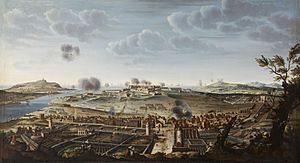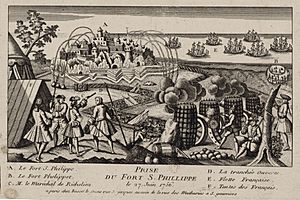Siege of Fort St Philip (1756) facts for kids
Quick facts for kids Siege of Fort St. Philip |
|||||||
|---|---|---|---|---|---|---|---|
| Part of the Seven Years' War | |||||||
 Attack and capture of Fort St. Philip on the island of Menorca, 29 June 1756, after the naval battle |
|||||||
|
|||||||
| Belligerents | |||||||
| Commanders and leaders | |||||||
| William Blakeney William Cunninghame |
Duke de Richelieu Roland-Michel Barrin de La Galissonière |
||||||
| Strength | |||||||
| 2,860 | 16,000 | ||||||
| Casualties and losses | |||||||
| 59 killed 149 wounded |
1,600 killed or died from disease 2,000 sick or wounded |
||||||
The Siege of Fort St. Philip, also known as the Siege of Menorca, was a big battle that happened from April 20 to June 29, 1756. It was part of the Seven Years' War. Menorca is an island in the Mediterranean Sea. Great Britain had controlled it since 1714. When France captured it, it was a big threat to the British navy in that area. The island was later given back to Britain after a peace treaty in 1763.
Why the Battle Happened
The island of Menorca was taken by the British in 1708 during another war. It was officially given to Great Britain in 1714. Menorca was very important because it helped control the western part of the Mediterranean Sea. However, it was also easy to attack. The Spanish people living there were not happy about British rule. Plus, the island was very close to French naval bases.
The British commander, William Blakeney, tried to make the local people happier. He even encouraged his soldiers to marry local women. But his efforts didn't really work.
A group in the British government later looked into why the island was lost. They found that the fort's defenses were in bad shape. Walls were falling apart, and gun platforms were rotten. Many important officers were also not at their posts. This included the fort's governor and the leaders of all four army groups there.
The French knew Menorca was weak. They hoped that taking it would make Ferdinand VI of Spain, the King of Spain, join them in the war. But King Ferdinand stayed neutral. Even though the Seven Years' War officially started in June 1756, France had already planned to attack Menorca. The Duke de Richelieu was put in charge of this mission.
The Siege Begins
On April 10, Richelieu sailed from France with 16,000 soldiers. They were protected by seventeen warships. They arrived at Menorca on April 18 and quickly took control of most of the island. On May 8, they started attacking Fort St. Philip.
Blakeney had been told about the French plans in March. He had worked hard to make the fort stronger. But there were many people inside the fort who were not soldiers, including over 800 women and children. This meant the fort would quickly run out of food and supplies.
The British navy tried to help. A group of ships from Gibraltar, led by Admiral John Byng, tried to reach the fort. But after a battle on May 20, which didn't have a clear winner, Admiral Byng decided to pull back. His retreat meant the fort was on its own. Blakeney surrendered on June 29, after the French captured some important outer parts of the fort.
During the siege, the British lost 59 soldiers killed and 149 wounded. The French had more casualties, with about 1,600 dead and 2,000 wounded. Since Blakeney surrendered under agreed terms, the British soldiers and civilians (about 4,378 people in total) were taken to Gibraltar by French ships.
After the battle, Admiral Byng was put on trial. He was found guilty of not doing his best to save the fort. He was executed in March 1757. A famous French writer named Voltaire later wrote that the English sometimes executed an admiral to encourage others to fight harder. Another British officer, Thomas Fowke, was also found guilty of not sending help soon enough and was removed from his job.
On the other hand, Blakeney was seen as a hero by the public. Even though he had health problems, people saw him as a brave soldier. However, some of his fellow officers, like his chief engineer William Cunninghame, thought he gave up too soon.
What Happened Next
After the French took Menorca, Hyacinthe Gaëtan de Lannion became the first French governor of the island. A British naval group, led by Sir Edward Hawke, arrived at Menorca shortly after the surrender. However, Hawke didn't have enough soldiers to try and take the island back. So, he left and sailed around the area for three months before going home. Some people later criticized him for not blocking the island, which might have forced the French to surrender due to lack of food.
The French held Menorca until 1763. In the Treaty of Paris (1763), Britain traded Menorca for the island of Guadeloupe. Later, in 1781, the Spanish recaptured Menorca during another war. It was officially given back to Spain by Britain in the Treaty of Paris (1783).
Images for kids
See also
 In Spanish: Sitio del Fuerte San Felipe (1756) para niños
In Spanish: Sitio del Fuerte San Felipe (1756) para niños




